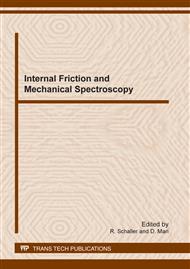p.422
p.428
p.434
p.443
p.449
p.455
p.461
p.467
p.473
Determination of Residual Stresses by Means of Dynamic Resonant Method
Abstract:
Young’s modulus and damping coefficient measurements performed on various materials by means of dynamic resonant method in free bending mode, exhibit transient effects during first heating, while there is no obvious structural evolution. It has been more particularly observed on sintered and rolled bulk materials as well as coated materials. It can be indubitably related to the release of internal stresses introduced during elaboration. The measurement of the resonance frequency shift associated to this release and the development of a model of beam vibration integrating the presence of internal stresses allow the estimation of the initial level of internal stresses. The mechanical model comes from the application of Hamilton principle minimizing potential and kinetic energies described by the Lagrangian of the vibrating system. Then, the effect of internal stresses is introduced, based on a model of pre-stressed vibrating beam found in literature. Three experimental illustrations are given: a HIP (high isostatic pressure) sintered MAX phase with compression internal stresses, a 70 % rolled Co base steel with very high elastic limit and anisotropic plane tension stresses and a platinum aluminide coating deposited on AM1 superalloy.
Info:
Periodical:
Pages:
461-466
Citation:
Online since:
January 2012
Authors:
Price:
Сopyright:
© 2012 Trans Tech Publications Ltd. All Rights Reserved
Share:
Citation:


